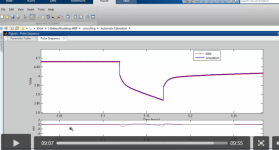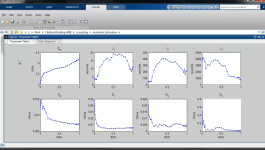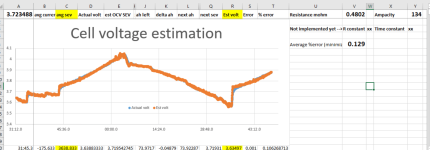plasmaticosine
10 µW
- Joined
- Sep 11, 2015
- Messages
- 5
Hi
I am trying to analyze terabytes worth of battery cycling and need some help. Essentially I have several megawatt hours of deployed and have been running for 1-3 years and would like to analyze the battery characteristics (Ah, equivalent resistance).
Any idea on where to start? I see matlab has a nice plugin that can estimate the parameters of a battery up to 3-RC branch circuits for high precision
http://www.mathworks.com/videos/automating-the-parameter-estimation-of-a-battery-model-95187.html
The problem is:
These batteries are in operation, and a extremely nice discharge CC pulses cannot be preformed. We have no control over the operation, we only have lots, and lots of data. Essentially it is spuratic current charging and discharging, I can post graphs later.
There are also temp sensor data every couple of cells. We have OCV data for brand new cells.
I was thinking of making an LTspice model to get it "close enough", then feed in a current profile and adjust the parameters until the simulated cell voltages matched the actual ones. It will be difficult to alter each parameter based on %SOC and temperature as matlab can do (I assume based on video). Thoughts or comments on approach?
I am trying to analyze terabytes worth of battery cycling and need some help. Essentially I have several megawatt hours of deployed and have been running for 1-3 years and would like to analyze the battery characteristics (Ah, equivalent resistance).
Any idea on where to start? I see matlab has a nice plugin that can estimate the parameters of a battery up to 3-RC branch circuits for high precision
http://www.mathworks.com/videos/automating-the-parameter-estimation-of-a-battery-model-95187.html
The problem is:
These batteries are in operation, and a extremely nice discharge CC pulses cannot be preformed. We have no control over the operation, we only have lots, and lots of data. Essentially it is spuratic current charging and discharging, I can post graphs later.
There are also temp sensor data every couple of cells. We have OCV data for brand new cells.
I was thinking of making an LTspice model to get it "close enough", then feed in a current profile and adjust the parameters until the simulated cell voltages matched the actual ones. It will be difficult to alter each parameter based on %SOC and temperature as matlab can do (I assume based on video). Thoughts or comments on approach?




